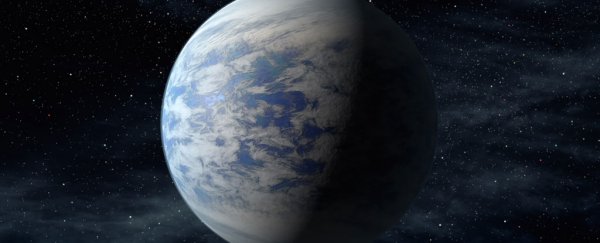While scientists are frantically trying to track down the hypothetical Planet Nine that's thought to be making its unusual orbit around the Sun, there's a chance our Solar System could have once played host to an equally intriguing and mysterious planet a very long time ago.
Now new evidence suggests that it's entirely possible that our Solar System used to contain a super-Earth – a class of large planets with up to 10 times the mass of Earth, but smaller than the giant planets that orbit our Sun. Our Solar System is a bit unusual in that it doesn't contain a super-Earth, as they're very common throughout the Milky Way, and the researchers have an idea about why it doesn't: the super-Earth, if it existed, could have strayed too close to the Sun and fallen into it.
If they're right, the hypothesis could also explain why the region of space within the orbit of Mercury – the planet closest to the Sun – is so bare. The super-Earth, on its way to being consumed by the Sun, would have collected all the space debris and cosmic matter on its one-way ticket into oblivion.
"The only (physical) evidence that super-Earths could have formed in our Solar System is the lack of anything in that region, not even a rock," astrophysicist Rebecca Martin from the University of Nevada, Las Vegas told Elizabeth Howell at Discovery News. "So they could have formed there sweeping up all of the solid material, but then later fell into the sun."
In an effort to understand why our Solar System doesn't feature any super-Earths, Martin and fellow researcher used computers to simulate how these massive worlds take shape. They can form in one of two ways: either close to the sun in their solar system, in which case they become very dense, or far out from their stars, which makes them less dense.
If a super-Earth did exist in our Solar System, it could have formed within a protoplanetary disk – all the gas and rocky debris that surrounds a star. Depending on the conditions within the disk, a 'dead zone' with little or no friction can see these chunks of matter start to clump together, potentially giving birth to new planets.
"The size of the dead zone must be large enough that it lasts for the entire disk lifetime," said Martin. "Since different systems may have different dead zone sizes, formation in the inner parts may not be possible in all systems and thus both formation locations may be operating."
And with enough gravity, a newly formed planet taking shape so close to its host star could well be sucked into it, leaving a sparse region of freshly swept space behind it.
"If the disc is sufficiently cool, the migration timescale for them to fall into the Sun is short enough for this to happen in the lifetime of the disk," said Martin.
There's no way of telling right now whether the hypothesis is right, but it's a fascinating idea – and it's possible that future research might one day be able to solve the mystery.
The findings are to be published in The Astrophysical Journal.
